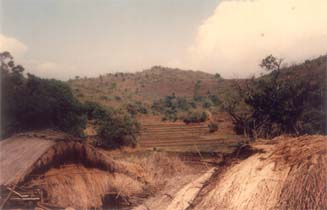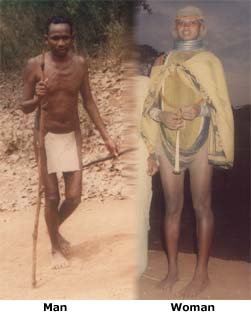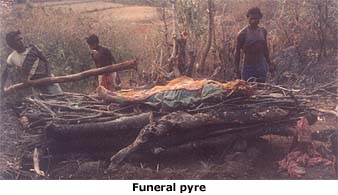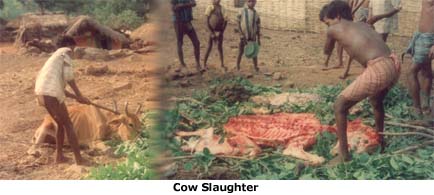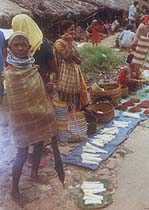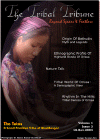Ethnographic Profile Of Highland Bonda of Orissa
|
Appearance The Bonda, also spelt as Bondo, is one of the very primitive tribal communities living in the uphills of Konda Kamberu range of the Eastern Ghats in South Western Orissa. They are short stature people with austroloid features, and speak a dialect ("remo-sam", where 'remo' means man) of southern Mundari group of Austro-Asiatic language. As these people were living on the hills, they came to be known as Bonda Highlanders in the British reports. Verrier Elwin made them well known in the name, in the princely state records(1950), as 'Bonda Paraja' or Ryots. Later some Bonda families made settlements at the foot hills and were mentioned as lower Bonda. These section mixed with outsiders, but the upper group shied away.
In 1981 census report the Bondas counted at 5895. The 1991 census data have not been published. But the government agency namely Bonda Development Authority enumeration of 2001, show their population limited to 5565 individuals.
Despite their aggressive behaviour towards unknown people, they possess a simplistic mind unable to negotiate with the developed world. A Bondo man always carries weapons like bow and arrow, an axe and sharp knives. As they remain intoxicated most of the time with fermented 'Sago-Palm' and other juices, they often enter into arguments snowballing into quarrel occasionally leading to homicidal assault. For these reasons, till a couple of decades back, the outsiders did not dare to venture into the Bonda areas, instead preferred to stay away.
The hill Bondas are divided into exogamous sections such as: a) the Barajangar group and b) the Gadaba group. The Barajangar group or the country of Twelve Confederacy constitute twelve villages which are situated on the hill tops within the hill ranges and are thought to be the original Bonda villages. The Gadaba group consists of the villages that emerged from the Barajangar group, the original Bonda villages, due to population expansion. These daughter villages are not necessarily situated on hill tops. Of all these villages, Mudulipada is considered as the central of the whole Bonda country and enjoys the status of being its capital where the chief deity is propitiated and the chief (Naik) of the Bonda land has his throne. However, the people of Gadaba group of villages who under the influence of the Gadaba tribe (another neighbouring primitive community), do not acknowledge the authority of the Naik of Mudulipada; they have no interest in the cult of the chief deity; and they may even keep there festivals in different dates and even perform in different ways. This second group have descended to foothills. The entire upper Bonda tribe is divided into two exogamous moieties or baish namely Cobra (Ontal) and Tiger (Druka) of which the people of Cobra group are most numerous. Both these moieties share common exogamous clans (Mada) named after village functionaries, like, Muduli, Kirsani, Badnaik, Dhangada-Maghi, Chalan, Dora, Sisa etc. The Bonda people prefer to establish separate households soon after their marriage. Their family forms are mostly(68.9%) nuclear. Patrilineality, patriarchy and patrilocality are respectively, the norms of descent, authority and residence . But the female voice is highly respected by the male members due to their high economic importance in the society and their seniority in age. The Bondas mainly practise two types of marriage (Dosinge), namely, arranged marriage (Salak-Boyi-Dosinge) and capture marriage (Wai-Boyi-Dosinge). Payment of bride price (Ginning) is prevelant in both cases. While a cow, a bullock and about 20-30 Kgs of cereals are the prescribed amount of bride price in case of an arranged marriage, it goes upto 3-15 or even more number of cattles and cereal weighing about a quintal or so in case of a capture marriage. However, the amount depends upon the nature and severity of the capture made by the grooms party. One of the most import features of Bonda marriage is that a woman aged about 20-25 years marries a boy aged about only 7-10 years. The intention behind this practice, is to ensure economic security of the wives in their old age. As the woman does most of the activities for sustenance, when she becomes old, the younger husband takes up that activity and supports the old wife. The young husband remains obedient to his wife as she has trained and groomed him to maturity. As he becomes adult, they start conjugal life to procreate offspring. Bonda society mantains dormitories for boys (Ingersing) and girls (Selaniding). The boys of one village visit Selaniding of young girls of another village, where they can choose their life partners through prolonged intimacy. This arrangement also keeps both the sexes satisfied. These people pay more importance to the girl child, as girls are economically important. Age seniority of the wife also keeps the men under control. This is just the reverse of the practice prevalent among the non-tribal Indian people. Husbands observe certain restriction on food and do not move out of the village when there wives are pregnant. The 'Enlightened' Bondas have now started abandoning this practice. Piercing the ear lobes is a must and done in infancy, but scalp shaving is done at three years of age. They have no elaborate idea of name giving so same names may recur in a family. Names are given according to birth days, i.e., Monday, Tuesday, etc. irrespective of gender. For example a boy born on Monday will get the name 'Soma' and girl will be 'Sombari', if one is born on Tuesday the boy's name will be 'Mangala', a girl 'Manguli' and so on.
If a person dies, he or she is cremated on pyre, but the cause of death is ascertained. The surviving spouse goes to the cremation ground and takes a piece of half burnt bone and hits with a pebble. If it crumbles, the death is not by any sorcery.Otherwise, the culprit is searched through magical method by a 'Shaman'. When the guilty is ascertained, either the village council penalise him or revenge is taken by magical practices.
On the tenth day of death of an adult, a cow is slaughtered and feast is given to the kins and 'Soru-brothers' (a socio-religious brotherhood). If the descendant is not capable at that time, either he is granted time upto twelve months by the Soru-brothers or he can take loan from any fellow villager and become his bonded labour. The Bondas are primarily animistic but also include Hindu Gods in their pantheon. Unlike the Hindus, they consume beef and meat of dead animals. As stated earlier they associate themselves with Ramayana hero Lord Rama whose sword is their supreme deity i.e. Patkhanda Mahaprabhu, situated in a Great Banyan Tree. Besides this, the Sun and the Moon are worshipped with a number of demi gods residing in different streams, forest, swiddens, villages, homes etc. They are thought to be responsible for good and bad in their daily lives. The Disharies or Shamans act as the intermediaries between the supernatural powers and human beings. Wrath of ghosts of the recently deads are considered as malevolent entities who are responsible for crop failures, death of domestic animals, diseases etc. So the Bondas fear such ghosts and do not go out alone at night. If required, they go in groups by singing songs to ward off those beings of the unseen world. The demi-gods are worshipped in different shrines mainly at Sindibor, the sacred stone platform in each village where the important socio-religious activities are conducted. Law and order are maintained in the society through the village functionaries. Each clan is headed by a Munda who is responsible to solve minor cases relating to the members of his group. However, the cases relating to homicide, adultery, divorce, land related disputes etc. are referred to the Munda of Badnaik clan who acts as secular head of the village and enforces law and order in the village society. The trials are held at the Sindibor and the Badnaik is assisted by Kirsani Munda who is also assisted by the Chalan Munda. All these functionaries enjoy high social status and the office is almost hereditary. But if somebody is found unsuitable for the post can be removed by consensus.
The Bonda people live in the safe altitude of hills amidst forest. Basically they lead a life of hunter and food gatherer for most part of their existence. In course of time hunting became illegal and forest declined rapidly. They began hill slope cultivation in slash and burn (Swidden) method. They could not develop efficiency in this and the crops produced was meager for their requirement. Forest adaptation made them self sufficient and fearless people who did not allow anybody to enter their territory and themselves did not come down to take others help. The government development agencies were trying for a long time to make the Hill Bondas aware of the modern methods but met with little success.
For last two decades or so various non government agencies and also government people became partially successful to befriend the High land Bonda people and taught them agricultural methods. Now the Bondas are gradually responding to the development activities to eliminate poverty illness and ignorance. Much is awaited to be done.
|
Reference : Bonda Highlanders by Verrier Elwin .- Oxford University Press(1950)
Photographs : by the author

